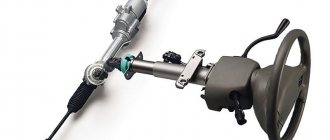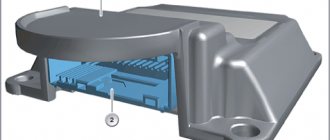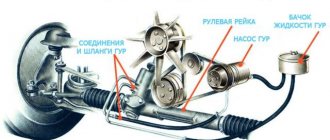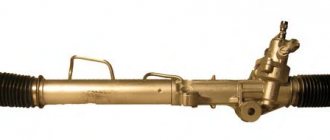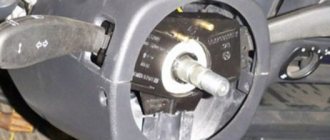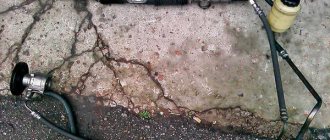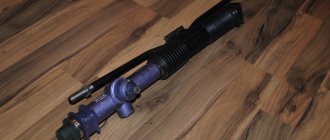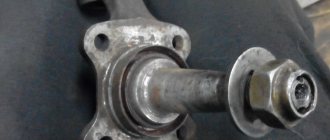Steering Regulations
Requirements for steering control elements of vehicles are regulated by UNECE Rules No. 79.
This document contains mainly design requirements for these elements. The basic operational requirements, according to which the technical condition of the steering is checked, are set out in STB 1641-2006. The total play in the steering is the angle of rotation of the steering wheel from the position corresponding to the beginning of the steering wheels turning in one direction to the position corresponding to the beginning of their turning in the opposite direction.
The total play in the steering under regulated test conditions should not exceed the limit values established by the manufacturer in the operational documentation, and in the absence of such data should not exceed:
- 10° for passenger cars and truck and bus units based on them
- 20° for buses
- 25° for trucks
The start of steering wheel rotation is the angle of rotation of the steering wheel by (0.06 ± 0.01)°, measured from the straight-line position.
When checking the total play, the following preconditions must be met:
- The steering wheel tires must be clean and dry
- the steered wheels must be in a neutral position on a dry, level, horizontal asphalt or cement concrete surface
- tests on vehicles equipped with power steering are carried out with the engine running
The value of the total play in the steering is determined by the angle of rotation of the steering wheel between two fixed positions of the beginning of rotation of the steered wheels as a result of two or more measurements.
The tension of the power steering pump drive belt and the level of working fluid in the reservoir must meet the requirements established by the vehicle manufacturer in the operating documentation.
During the organoleptic inspection of the steering system, compliance with the following regulatory requirements is checked:
- The steering wheel must rotate without jerking or jamming throughout the entire range of its rotation angle; inoperability of the power steering (if equipped on the vehicle) is not allowed
- spontaneous rotation of the steering wheel from the neutral position when the vehicle is stationary with power steering and the engine is running is not allowed
- The maximum rotation of the steering wheel must be limited only by devices provided for by the design of the vehicle
- movements of steering parts and assemblies not provided for by the design relative to each other or the supporting surface are not allowed; threaded connections must be tightened and secured in the manner specified by the vehicle manufacturer
- The use of parts with traces of residual deformation, cracks and other defects in the steering mechanism and steering drive is not allowed
Damage and absence of fastening parts of the steering column and steering gear housing, as well as increases in the mobility of steering gear parts relative to each other or the body (frame) not provided for by the vehicle manufacturer in the operational documentation are not allowed.
Mobility of the steering column in planes passing through its axis is not allowed. The steering column must be securely connected to the mating parts and not be damaged. The steering column locking device with adjustable steering wheel position, as well as the device preventing unauthorized use of the vehicle, must be in working order.
Axial movement and swing of the steering wheel plane, swing of the steering column are determined by applying alternating forces to the steering wheel in the direction of the axis of the steering shaft and in the plane of the steering wheel perpendicular to the column, as well as alternating moments of forces in two mutually perpendicular planes passing through the axis of the steering column.
The mutual movements of the steering drive parts, the fastening of the steering gear housing and the steering axle levers are determined by turning the steering wheel relative to the neutral position by 40...60° in each direction, as well as by applying an alternating force directly to the steering drive parts.
What is the beginning of a steering wheel turn?
When measuring the total steering play, it is necessary to take into account the beginning of the steering wheel rotation. To determine this parameter, it is necessary to use special equipment that allows you to recognize the movement of the steering wheel in one direction or the other by 0.06 degrees.
This value cannot be determined visually. To do this, the rotary wheels are set to the position of linear movement of the vehicle. The angle of deviation from the center point by 0.06 degrees is the beginning of the steering wheel rotation.
How many degrees of steering play is allowed according to traffic regulations in the Russian Federation?
- How many degrees of steering play is allowed according to traffic regulations in the Russian Federation?
- Permissible steering wheel play according to traffic regulations
- Diagnostics and determination of backlash
- Trouble-shooting
- Consequences
- Driving danger
- Responsibility for faulty steering
Backlash is the free movement of the steering wheel until the car begins to turn in one direction or another. It is clear that this inevitable phenomenon, characteristic of any car, should not exceed permissible limits. Read further in the article about why excess play occurs, how to eliminate it, and what punishment can be incurred for driving with a faulty car control system.
How to measure backlash
You can measure the total play at a service station or yourself. When performing the procedure, several prerequisites must be met:
- The wheels on the front axle must be in neutral. There must be a hard surface of concrete or asphalt underneath;
- the tires on the wheels must be completely dry and clean;
- the engine must be started. This criterion is relevant when performing diagnostics on a vehicle equipped with power steering;
- it is necessary to strictly comply with the manufacturer's requirements regarding the tension of the power steering drive belt, as well as the fluid level in it.
The amount of total play is determined by measuring the angle of rotation of the steering wheel in the interval between the fixed points of change in the position of the wheels (right and left). To obtain an accurate parameter, the measurement must be repeated at least two times in a row.
How to avoid getting divorced
All motorists should firmly understand that measuring the steering wheel play and prohibiting the operation of the vehicle if the indicator is above the norm is carried out only during maintenance and receipt of a diagnostic card. This knowledge will help you avoid the scam from traffic police inspectors that is popular on domestic roads.
The situation looks like this. The driver is stopped by a traffic police inspector and informed that he suspects that the steering play has exceeded the indicator. The employee offers to check the parameter on the spot and resolve the issue.
For measurement, a pre-prepared device is used, which, according to inspectors, is reliable and error-free. The result of such a check is always not in favor of the driver. An unacceptable degree of total play will be detected in the vehicle, and its owner will be offered to evacuate the car to an impound lot or “negotiate” on the spot.
Actions that a driver should take in a similar situation:
- Refuse to check the steering wheel free play indicator directly on the road (or, for example, at a stationary traffic police post). Such an examination can only be carried out at a licensed station and subject to all conditions. A current diagnostic card serves as confirmation of the vehicle's serviceability. Other roadside checks are not permitted.
- If an inspection does occur, then it is important to know that inspectors do not have the right to evacuate the car to an impound lot. The driver should insist on his rights without escalating the conflict. It is important to write down the data of the inspectors in order to appeal against their unlawful actions in the future and submit an application to the prosecutor’s office.
Diagnostics and determination of backlash
The range of play is easily determined by a play meter. For example, K524M or ISL-M, which in a couple of minutes are able to accurately set the distance of free movement of the steering wheel.
Diagnostics of the state of the car control system proceeds as follows:
- The engine starts and then idles.
- The front wheels are aligned along the longitudinal axis of the car.
- The operation of the hydraulic power steering is checked.
- The steering wheel turns alternately in one direction and in the opposite direction. In this case, it is necessary to fix the moments when the wheels begin to turn in the given vectors. The angular distance traversed by the steering wheel between these moments is the desired backlash.
It may exceed the established norm due to changes in the design features of the machine control system or due to the destruction of its parts.
Most often this happens due to:
- wear of teeth on the steering rack bar or gear;
- destruction of the wheel bearing;
- breakage of steering wheel tips and rods;
- unscrupulous repair of the vehicle chassis;
- failure of the lower or upper ball joints;
- excessive force when pulling the rack;
- old hydraulic oil;
- loose crankcase fasteners;
- wear on the pendulum arm of the axle or bushings;
- poor-quality adjustment of the clutch of the roller mechanism and the “worm”.
Trouble-shooting
If there is excessive play in the steering wheel, you must:
- Try to adjust the screws that strengthen the universal joints and are located on the steering shaft.
- If this does not help, you should tighten the adjustment nut on the rack to eliminate the gaps between the drive gear and the gear bar.
- Adjust the steering linkage joints. If they are damaged, tighten the screws and steering rods.
- If there is no positive result, you will have to disassemble the steering structure and replace damaged parts.
Consequences
The car is an object of increased danger. If its control system is faulty, it becomes many times more dangerous.
Driving danger
It’s easy to imagine what will happen if the car’s chassis stops clearly responding to the driver’s actions. The sad consequences of this can affect not only himself and the passengers of the car, but also other road users, as well as pedestrians. In emergency situations, the driver simply will not be able to avoid danger, no matter how much driving experience he has behind him.
Responsibility for faulty steering
That is why all drivers must obey the immutable rule: if there is a malfunction in the vehicle control system, stop driving immediately . The same is officially required by traffic regulations. If the play in the vehicle's steering system exceeds the established standards, operation of this vehicle is prohibited. Ignoring this prohibition in accordance with Part 2 of Art. 12.5 of the Code of Administrative Offenses of the Russian Federation is fraught with penalties in the amount of 500 rubles. and a ban on operating the machine until the malfunction is eliminated.
The costs of towing the car to the impound lot and staying there, which accompany the ban on the operation of the car, fall on the shoulders of the careless driver.
The free movement of the steering wheel, which does not cause a change in the vehicle’s motion vector, instills anxious feelings in some drivers, while others simply do not pay attention to it. The first of them are wrong when the steering wheel play is permissible, while the second, when this value is exceeded, show criminal carelessness. In order not to go to extremes, it is enough to use a simple backlash meter to have an idea of the controllability of your car and drive calmly and safely.
Subscribe to our feeds on social networks such as Facebook, Vkontakte, Instagram, Pinterest, Yandex Zen, Twitter and Telegram: all the most interesting automotive events collected in one place.
Consequences of driving with a lot of play
If the driver ignores the gradually increasing steering play for a long time (and this happens almost imperceptibly), then over time the car will stop responding in a timely manner to the driver’s actions - late turning of the wheels with a large turn of the steering wheel. At a low speed you can control the car, although such a ride cannot be called comfortable, especially when the car moves along a rut - the vehicle will constantly need to be “caught”, since it will always try to change its trajectory.
But high speed and large play in the steering wheel will sooner or later lead to an accident, especially if the car is moving in heavy traffic. A driver can easily lose control of the vehicle when the steering wheels hit a pothole or any uneven surface.
Every driver needs to monitor the angle of rotation of the steering rack. For an experienced motorist it will not be difficult to notice this, but for an inexperienced one it is much more difficult to do. To facilitate this task, special equipment was developed, which is available in many car services.
